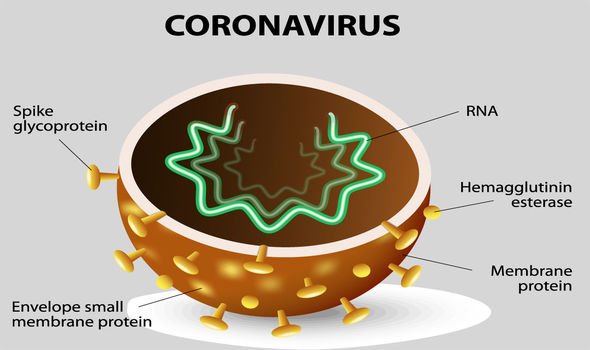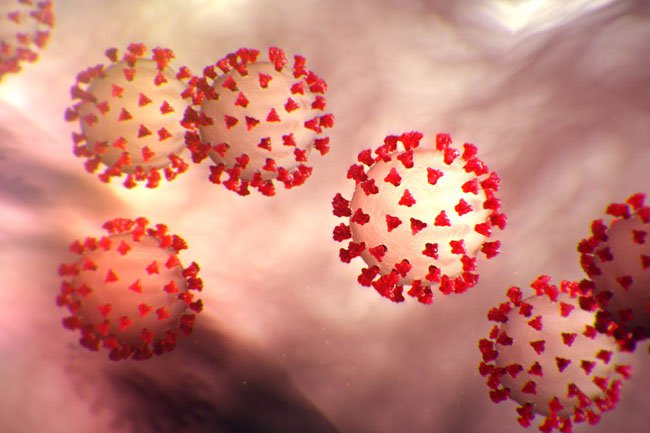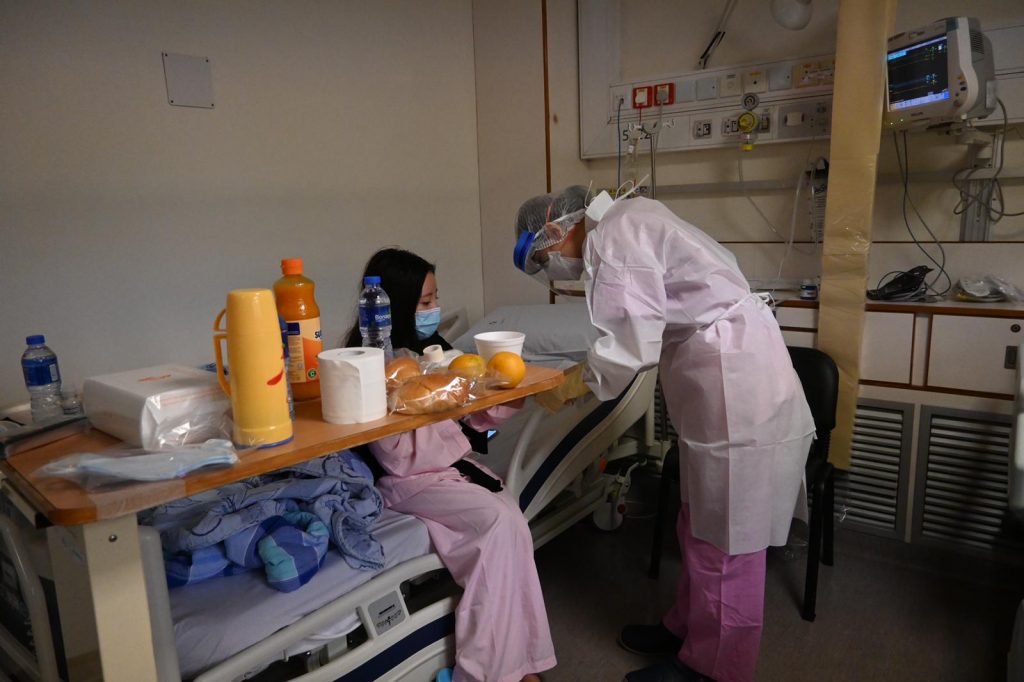Coronavirus belongs to the family of viruses, which is in Nidovirales order, refers to the viruses capable of replicating by using a nested mRNAs set (Nido means nest). The subfamily of coronavirus is further classified into:
- Alpha
- Beta
- Gamma
- Delta.
The existing human coronavirus comes in 2 of these four genera:
- Alpha coronavirus as HCoV-NL63 and HCoV-229E.
- Beta coronavirus as HCoV-OC43, MERS-CoV, SARS-CoV, and HCoV-HKU1.
Composition of the virus:
Coronavirus is a medium-sized RNA strand that is enveloped. The name of coronavirus is derived from its crown-like characteristic appearance, which becomes visible under the electron microscope. Until now, these viruses are considered to be having the largest viral RNA genome ranging in length from 27 kb to 32 kb. Replication of RNA of this virus takes place in the cell cytoplasm of the host through a unique mechanism that involves polymerase binding of RNA with a leader sequence, which then detaches and re-attaches on multiple sites, thus, allows the production of a set of mRNAs (nested) molecule with 3’ends.

This viral genome encodes for four or five structural proteins as E, M, S, N, and HE.
SARS coronavirus, HCoV-NL63, and HCoV-229E possess 4 genes that encode the E, M, S, and N proteins, whereas HCoV-HKU1 and HCoV-OC43 contain 5th gene which encodes HE protein.
- The spike protein “S” projects out through the envelope of the virus and forms a characteristic shape of the crown. This crown is richly glycosylated, which probably forms a homotrimer, and helps in the mediation of receptors binding along with fusion with membranes of host’s cells. Antigens which stimulate the antibodies (neutralizing antibodies) and important cytotoxic lymphocytes, as well, are present on the S protein.
- The membrane protein has an N-terminal (short), which projects on the exterior surface of the viral envelope and spans the viral envelope for three times, thus, leaving a long terminus C inside the viral envelope.
- The role of M protein is significant in the assembly of viral structures.
- The N protein or nucleocapsid protein is associated with the RNA genome for the formation of the nucleocapsid. It might be involved with viral RNA synthesis regulation and may cause an interaction with protein M during the budding of the virus.
- HE protein or hemagglutinin-estrate glycoprotein is found in beta coronaviruses, only, as in HKU1, and HCoV-OC43. The HE protein binds to neuraminic acid on the surface of the host cell, permitting the adsorption of the virus inside the membrane, initially. The esterase in HE protein cleaves neuraminic acid from the acetyl group.
- The small envelope protein E, along with other proteins N and M, are needed to assemble and let the virus release properly.
Types of coronavirus:
Most common Human coronaviruses:
- Alpha coronavirus-229E
- Alpha coronavirus- NL63
- Beta coronavirus-OC43
- Beta cornvirus-HKU1

Less common human coronaviruses:
- Beta coronavirus SARS-CoV (causing severe acute respiratory syndrome).
- Novel coronavirus, (2019).
- Beta coronavirus MERS-CoV (cause of Middle East Respiratory Syndrome).
Stereotypes:
Coronaviruses are widely spread among mammals and birds, with bats providing the major host and variety of viral genotypes. Human and animal coronaviruses basically fall into 4 specific genera.
As discussed above, there are 5 non-SARS stereotypes of coronavirus, which are found to be associated with diseases found in humans as novel coronavirus, HCoV-OC43, HCoV-229E, HCoV-HKU1, and HCoV-NL63.
- The alpha-coronaviruses genus basically includes two species of the human virus as HCoV-NL63 and HCoV-229E. HCoV-229E species like different other animal alpha-coronaviruses use N-(APN) aminopeptidase as a major receptor side.
- In contrast to it, HCoV-NL63, like SARS-CoV, uses ACE-2 (angiotensin-converting enzyme-2) for receptor binding.
- The two non-SARS human species of genus beta coronavirus, HCoV-HKU1, and HCoV-OC43 have an activity of esterase, which utilizes the residues of sialic acid as receptors. This genus also exists in bat viruses.
- The gamma coronavirus genus consists of primarily avian coronavirus. The most prominent feature of this virus is infectious bronchitis in chickens. This is thought to be an important veterinary pathogen that causes the reproductive tract and respiratory diseases in chickens.
- The genus of delta coronavirus is found in different species of songbirds.
Transmission of coronavirus:
Mostly coronavirus spreads through human to human contact or a relatively close contact of about 6 feet distance. Human-to-human transmission is found to be occurring majorly via respiratory droplets, which are produced when an infected person sneezes or coughs in a similar fashion as in influenza and other pathogens spread.
These released droplets can land anywhere specifically on noses and mouths of people staying nearby the infected person and gets inhaled in the lungs.
Still, it is a bit uncertain whether the coronavirus transmits when someone touches any infected object or surface and then touches their eyes, nose, or mouth.
At first, it was found that coronavirus originated from seafood markets while they transferred to humans through a mammal carrier.
Generally, in the case of viral diseases, the transmission of the virus occurs when the person becomes symptomatic of disease or becomes the sickest. But according to a report, this isn’t the same case with coronavirus, it spreads from even non-symptomatic patients to other patients as well.
Coronavirus isolation:
As the coronavirus is a fatal and highly contagious disease, therefore, it is always advised for people to stay away from infected sources and prevent any close contact. People suffering from coronavirus are advised to keep themselves in self-isolation.
Self-isolation refers to an act of distancing yourself from the rest of the population in order to avoid contact and transmission of disease droplets through air and respiration.
Self-isolation of affected individuals includes:
- Staying at home and not visiting work or classes.
- Don’t go near any person to avoid the spread of disease.
- It is advised for individuals to take measures which we take in case of a heavy cold.

Self-isolation or coronavirus isolation also involves going to markets. At first, it was permissible for infected individuals to visit the markets or shops for their food and groceries, but now on account of immense spread, these individuals are asked to not get out of home and visit markets rather opt for home deliveries for groceries.
For people who are living inside a family or home, it would be difficult for them to isolate themselves from the whole family, and it is dangerous for the whole family as well. The best option in such a case can be living any health care facility with proper isolation rooms until the complete recovery or until the symptoms of virus subside, and they aren’t fatal anymore.
If a person is staying at home and feels unwell, then he should consider calling some health care facility instead of personally going there for the checkup.
As a lot of countries have evacuated their citizens from China to prevent them from developing this disease. But in the homelands of these citizens, the danger of coronavirus has increased.
In order to avoid it, travelers should put their selves in a temporary isolation state before interacting with their families until the screening and check up for the virus is completely done.
It might feel uncomfortable for these individuals to move back to their homes and stay in isolation from their families, but it is an important step for the protection of themselves and others from this fatal disease.
Summary:
There are basically four types of coronavirus in humans. Coronavirus tends to transmit from one individual to others through droplets present in air after coughing or sneezing of an infected person.
